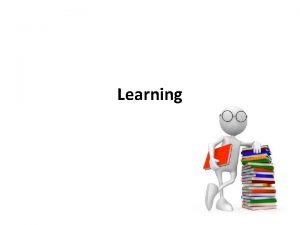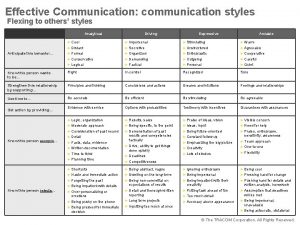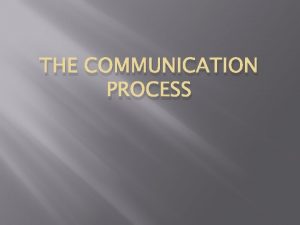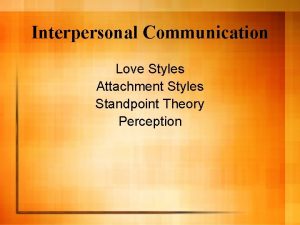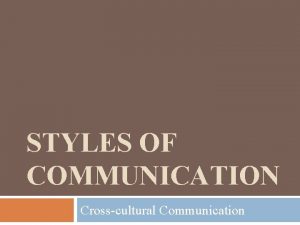The Communication Process Styles of Communication 4 styles

















- Slides: 17

The Communication Process

Styles of Communication 4 styles of communication: 1. Passive Communication - occurs when the listener is not active or verbal in response. - people usually act passively because they do not like to cause conflict.

Styles of Communication Example of passive communication A teacher asks a student to work on a math exercise in class. If the student knows how to complete the exercise, they will quietly and passively start working on the exercise.

Styles of Communication 2. Passive-Aggressive Communication - occurs when a person is responsive, but in an often negative and/or sly way. - if someone doesn't want to do what is asked of them, they may use distractions to avoid a task.

Styles of Communication Example of Passive-Aggressive Communication A student is asked to complete a math exercise in class. They may start writing notes, doodling, listen to their i. Pod, etc.

Styles of Communication 3. Aggressive Communication - occurs when the person is bold and assertive, to the point of being considered pushy. - people usually act aggressively when they feel either personally attacked or pressured.

Styles of Communication Example of Aggressive Communication A teacher asks a student to work on a math exercise in class. The student feels pressure to comply, so instead tells the teacher they will not do it causing a clear battle for control of the classroom.

Styles of Communication 4. Assertive Communication - occurs when the person is confident in their response and often demonstrates a positive attitude. - they are usually well-liked by others because they have a positive attitude and speak their mind in a calm and controlled manner.

Styles of Communication Example of Assertive Communication A teacher asks a student to complete a math exercise in class. An assertive student may or may not know how to complete the assignment. If they do know, they will work hard to complete it, if they do not know how to complete the exercise, they will raise their hand ask the teacher for help.

Listening - involves hearing sounds, translating the sounds into words/phrases, and processing meaning from the words.

Listening - listening and hearing are not the same thing. - hearing is when ears pick up sound waves and transmit these waves to your brain.

Modes of Listening 3 modes of listening: 1. Combative Listening - the speaker’s message is not being heard. - the listener is more interested in arguing their own point than listening to the speaker’s message.

Modes of Listening Example of Combative Listening The listener looks for breaks in the conversation so they can give their point. May attack points that they do not agree with.

Modes of Listening 2. Passive Listening - the person listening seems interested but does not provide any kind of feedback to the speaker.

Modes of Listening Example of Passive Listening The listener might use phrases like ‘I understand’ or ‘tell me more’ the speaker may wonder if the listener heard anything they said.

Modes of Listening 3. Active Listening - the listener is paying attention to the speaker (making eye contact, not interrupting).

Modes of Listening Example of Active Listening Active listener will insert phrases into the conversation like ‘I agree’ or ‘I understand when you say that…’ or ‘So, you are saying…’
 Hình ảnh bộ gõ cơ thể búng tay
Hình ảnh bộ gõ cơ thể búng tay Bổ thể
Bổ thể Tỉ lệ cơ thể trẻ em
Tỉ lệ cơ thể trẻ em Voi kéo gỗ như thế nào
Voi kéo gỗ như thế nào Chụp phim tư thế worms-breton
Chụp phim tư thế worms-breton Hát lên người ơi alleluia
Hát lên người ơi alleluia Môn thể thao bắt đầu bằng từ đua
Môn thể thao bắt đầu bằng từ đua Thế nào là hệ số cao nhất
Thế nào là hệ số cao nhất Các châu lục và đại dương trên thế giới
Các châu lục và đại dương trên thế giới Công thức tính độ biến thiên đông lượng
Công thức tính độ biến thiên đông lượng Trời xanh đây là của chúng ta thể thơ
Trời xanh đây là của chúng ta thể thơ Mật thư tọa độ 5x5
Mật thư tọa độ 5x5 Làm thế nào để 102-1=99
Làm thế nào để 102-1=99 độ dài liên kết
độ dài liên kết Các châu lục và đại dương trên thế giới
Các châu lục và đại dương trên thế giới Thơ thất ngôn tứ tuyệt đường luật
Thơ thất ngôn tứ tuyệt đường luật Quá trình desamine hóa có thể tạo ra
Quá trình desamine hóa có thể tạo ra



















